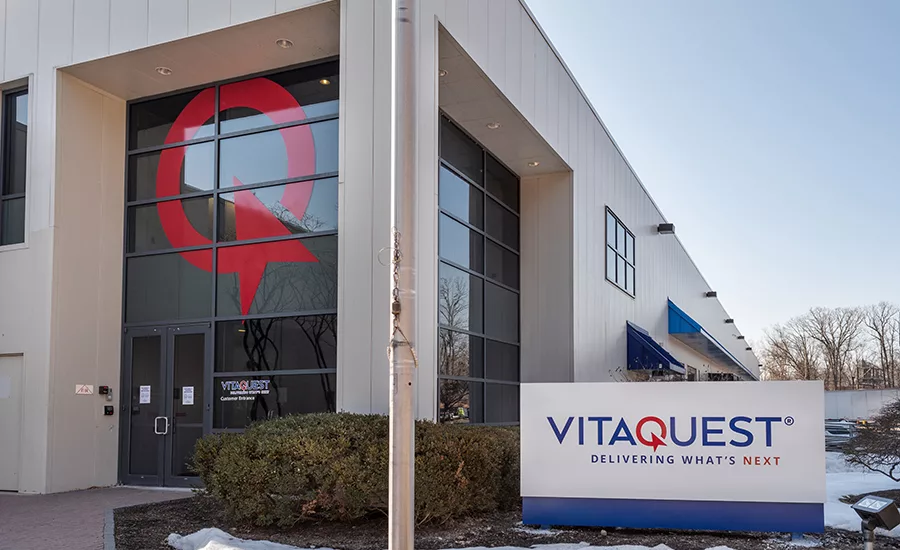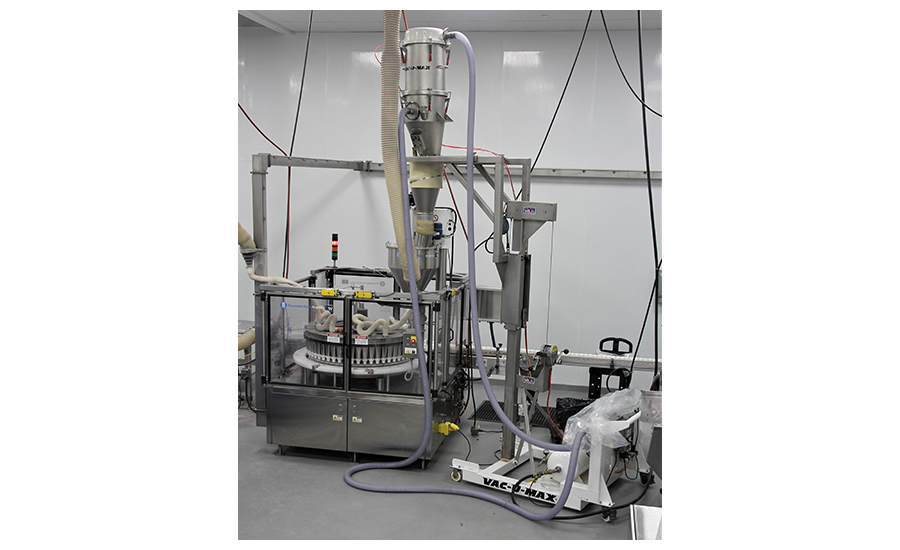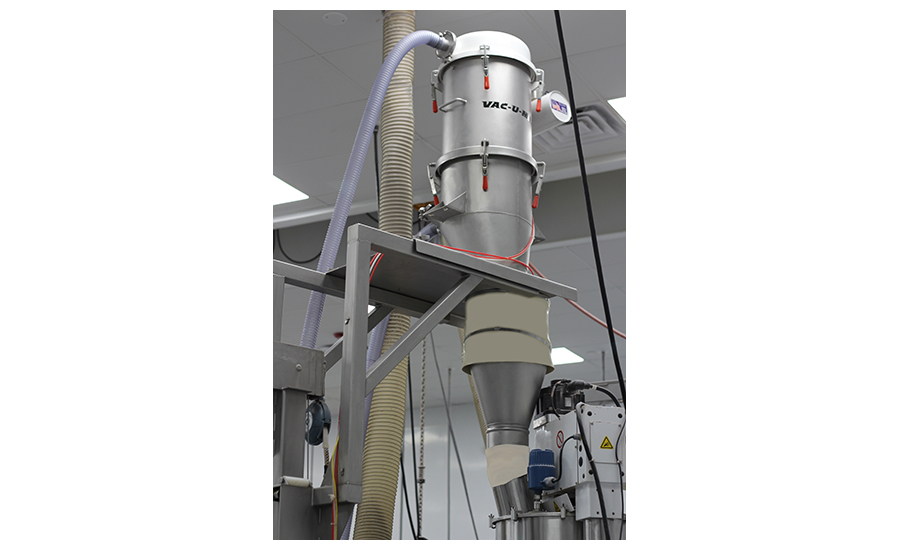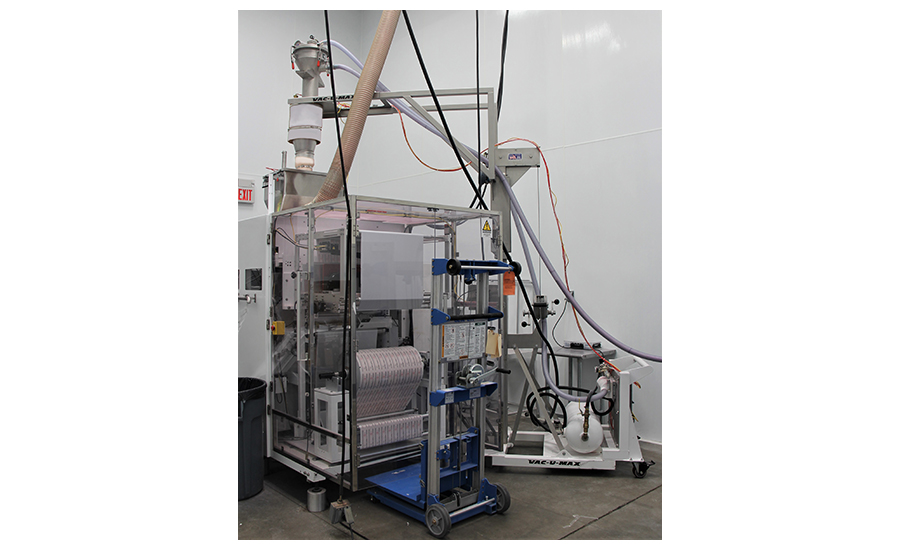Vacuum conveyors offer 'get-up-and-go' for Vitaquest
The functional foods manufacturer recently installed the 10th vacuum conveyor at its 200,000 sq.-ft. facility

Since 1977, Vitaquest International has delivered innovation in nutraceutical development by providing nutritional manufacturing solutions. Photos courtesy Vac-U-Max
Vitaquest’s humble beginnings in a garage have evolved over the past 40 years, and today the company is a global nutraceutical and functional foods custom contract manufacturer producing, packaging and labeling over 4,000 formulations for more than 500 brands in over 75 countries. Such growth requires continuous investment in facilities and a commitment to innovation.
With a history of being an early adopter of the latest manufacturing technologies to support its customers and anticipate market requirements, Vitaquest leverages equipment to develop novel processes and products, such as the first shelf-stable consumer probiotic and the first stick pack design and delivery system.
Recently, the custom contract manufacturer accepted delivery of its tenth mobile vacuum conveyor at its new facility in New Jersey, where it formulates and blends ingredients, processes them into a range of dosage forms and packages them using packaging technologies such as pouches, stick packs, jars and vials.
At Vitaquest, the technology of choice for its powder filling lines are vacuum conveyors, and for more than 20 years the company has worked with Vac-U-Max for its powder conveying needs.
“Vacuum conveyors are the best choice for feeding filling lines for space savings, flexibility, reduced changeover time, simple operation and minimal maintenance,” says Vitaquest engineering manager, Angel Simeon, Jr.
The custom contract manufacturer still utilizes a few feeder screws but is making a conscious effort to move away from that technology, according to Simeon. “Screw feeders with hoppers require additional equipment to load the hoppers and more floor space. They are also heavier and take longer to set up and clean than vacuum conveyors.”

Functionality on the go
Mobile vacuum conveyors are complete conveying systems that have all of the same conveying system components as rigidly installed vacuum conveyors—the vacuum producer, the filter separator, the controls, convey tubing and a pickup wand—but on a compact, mobile conveyor frame.
The pick-up wand is standard with the mobile conveyor and is the primary device used by Vitaquest to pull material from plastic lined drums; however, bag dump stations, bulk bag unloaders, mixers and blenders also work with the mobile conveyors.
Like many in the food and pharmaceutical industry that use wands to convey materials from plastic lined drums, Vitaquest’s mobile conveyors utilize a wand with a bag guard (that looks similar to a muzzle) welded to the end of the wand to prevent the bags from being sucked into the conveying line.
Mobile conveyor systems raise the receiver in order to load auger fillers, mixers, reactors and other processing and packaging equipment and then lower the vacuum receiver back down to ground level for easy and safe cleaning and maintenance.

Safe and efficient operation, maintenance
Vitaquest’s commitment to its safety program means equipment and processes are scrutinized and audited by its safety manager in the quest of having zero injuries. Vacuum conveyors are reported to be inherently safer and more efficient than manual transfer of materials, and some of the most common reasons facilities implement them is to meet increased demand; mitigate ergonomic, fall, and fugitive dust hazards; reclaim expensive materials; and improve product quality through precision ingredient delivery.
Mobile vacuum conveyors add another element of efficiency in that a single mobile conveyor system can service multiple processes. When one type of packaging machine finishes a production run, it may be idle for the near future, but the mobile conveyor can be quickly cleaned and moved to another room for use with another type of product and packaging machine.
Setup and operation are immediate after connecting to electric power and compressed air supplies. The packaging machines interface with the mobile conveyor to ensure they never run out of ingredients.
“They have no problem keeping up with our standard use rates of 1,000 pounds per hour for our stick pack and pouch filling lines and up to 3,000 pounds per hour for our rotary fillers,” says Simeon.
The venturi-powered, mobile conveyors at the facility conform to FSMA sanitation regulations and require no tools or special mechanical skills to disassemble for product change-over. Venturi-powered units have no moving parts and do not generate heat within the packaging suite. Because there are no moving parts, maintenance in minimal.
“Maintenance is easy,” says Simeon. “It is just a matter of changing out the filter once in a while and the system is ready to go.”
Vitaquest utilizes segregated production suites and industry best cleaning practices throughout all its manufacturing and packaging operations. A comprehensive cleaning and sanitization of a production line is performed between each product changeover. A rotating schedule of cleaning and production reduces time and maintains a constant flow of finished product. This creates a dynamic environment where at any time, 5 to 10 production lines can undergo cleaning while the other lines remain operational.
“Cleaning is a whole lot easier and safer,” explains Simeon. “With mobile vacuum conveyors there is significant cost savings on changeover and assembly.”

Mixing it up with blender loading
Vitaquest is also implementing Vac-U-Max’s direct-charge blender loading system to load its 125 cubic foot vee blenders and ribbon blenders.
Direct charge blender loading is a unique adaptation of vacuum transfer, designed specifically for the direct-charge loading of blenders, mixers, reactors and any vessel capable of withstanding a vacuum.
With a facility’s blender or mixer as the primary receiver, the conveyor manufacturer configures systems specific to each application, providing the power source, filters, controls and adapters.
The new system to load the vee blender reduces safety and ergonomic concerns from excessive ladder climbing for manual loading. It will increase blender throughput by reducing the loading time, and it will be a much cleaner operation than manually dumping ingredients into the blenders from the mezzanine.
Currently the ribbon blenders are loaded with flexible screw conveyors which can degrade the ingredients and take significantly longer time to clean during changeovers.
“The new conveyors will eliminate an entire step in charging our blenders. It will save us a ton of time and extra manual labor the moment it is installed, and increase safety,” says Simeon. “[The] mobile conveyors support the Vitaquest motto of ‘Delivering What’s Next’ to our customers.”
Looking for a reprint of this article?
From high-res PDFs to custom plaques, order your copy today!







